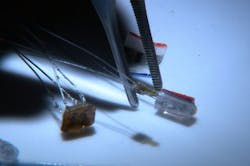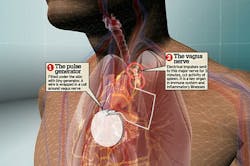Pharmaceuticals can be effectively used to treat many health conditions, but side effects are always a concern. Drug-free technologies have thus become a popular area of research, with implants emerging as one of the most promising areas of study.
One popular use for implants used to heal surgical wounds heal faster. Unfortunately, the improved healing may not be too helpful if the patient needs to be reopened to retrieve the implant. Researchers in Norway may have found a solution, having developed a magnesium circuit capable of transferring energy and being broken down by bodily fluids. This research will help patients heal faster without the need to retrieve the implant. It also has an environmentally friendly benefit, as it eliminates stockpiles of biohazard circuits from piling up.
DARPA’s ElectRx (pronounced electrics) uses neuromodulation to target a small group of neurons to diffuse to large areas of the nervous system. This means that an implant can monitor a patient’s health with a closed-loop circuit. If an organ is not functioning properly, the implant can stimulate the nerves necessary to regain normal function of a system or organ.
DARPA is aligning this program to help the understanding of the neurological circuits and their role in health. This is part of the government’s BRAIN Initiative—Brain Research through Advancing Innovative Neurotechnologies. DARPA plans to explore two technical areas: The first is is to understand the body’s neurological function as a system, mapping out the nerves that control and effect the body. The second is to develop non-invasive components that can interact with this neurological map.
It is hoped that this technology will someday be able to help alleviate post-traumatic stress syndrome, Parkinson’s, depression, and other conditions. One implant designed by GlaxoSmithKline (GSK) has been used to help patients deal with chronic inflammation and arthritis pain. This new technology uses a pulse generator to send an electrical impulse to the vagus nerve, reducing the activity of the spleen. A patient turns it on by waving a magnet over the device (that is under the collarbone). The device will run for three minutes and then turn off. Some patients in the study have already given up their medication, relying solely on this new device.
GSK is starting to look into whether this technology could use other types of implants, preventing the airway spasms of asthma, controlling the appetite in obese people, or restoring normal insulin production for diabetes sufferers. Its potential for epilepsy treatment is also being assessed. The sample size for the rheumatoid arthritis study was small, but this hasn’t affected the enthusiasm researchers or patients.


